The rise of Operator-led content: How to create content that can’t be ignored
Brands that win will be the ones publishing content that are original, specific, and experience-backed. They're the kind of content pieces that you can't ignore.

I believe content marketing is at a crossroads, and the lazy middle won’t survive it.
In the beginning, content was personal. You wrote because you had something to say. It wasn’t optimized. It wasn’t polished. It was real. And that made it resonate.
Anyone remember blogger?
I remember reading Joel Spolsky’s Joel on Software and Basecamp’s Signal v. Noise. They were operating manuals for how to think.
Intercom’s early essays? Straight from the minds of the operators. You felt like you were learning from the person who made the thing, not a marketing team describing it after the fact. I reached out to Des Traynor from Intercom and asked his thought process 8 years ago.
Here's what he said:

The hardest part, honestly, is coming up with good ideas for the category you're in and writing it in a way that truly resonate.
Which is why, the founder content is so crucial. They're often the ones with deep knowledge about the industry, persona, and have strong opinions. A close second to founder-content is getting your ICP to write content for you. This could either be your prospects or your teammate who fits your ICP definition.
This, I believe, is what Intercom did really well.
Unfortunately, they were like a needle in a haystack. While rest of the SaaS world industrialized content.
The rise and fall of sameness
The skyscraper and the hub-and-spoke model turned content into a volume game. “What is X?”, “Why you need Y”. Glossaries. Guides. SEO for the sake of SEO. Companies scaled up content ops to flood Google with content that looked smart but read empty.
And for a while, that worked.
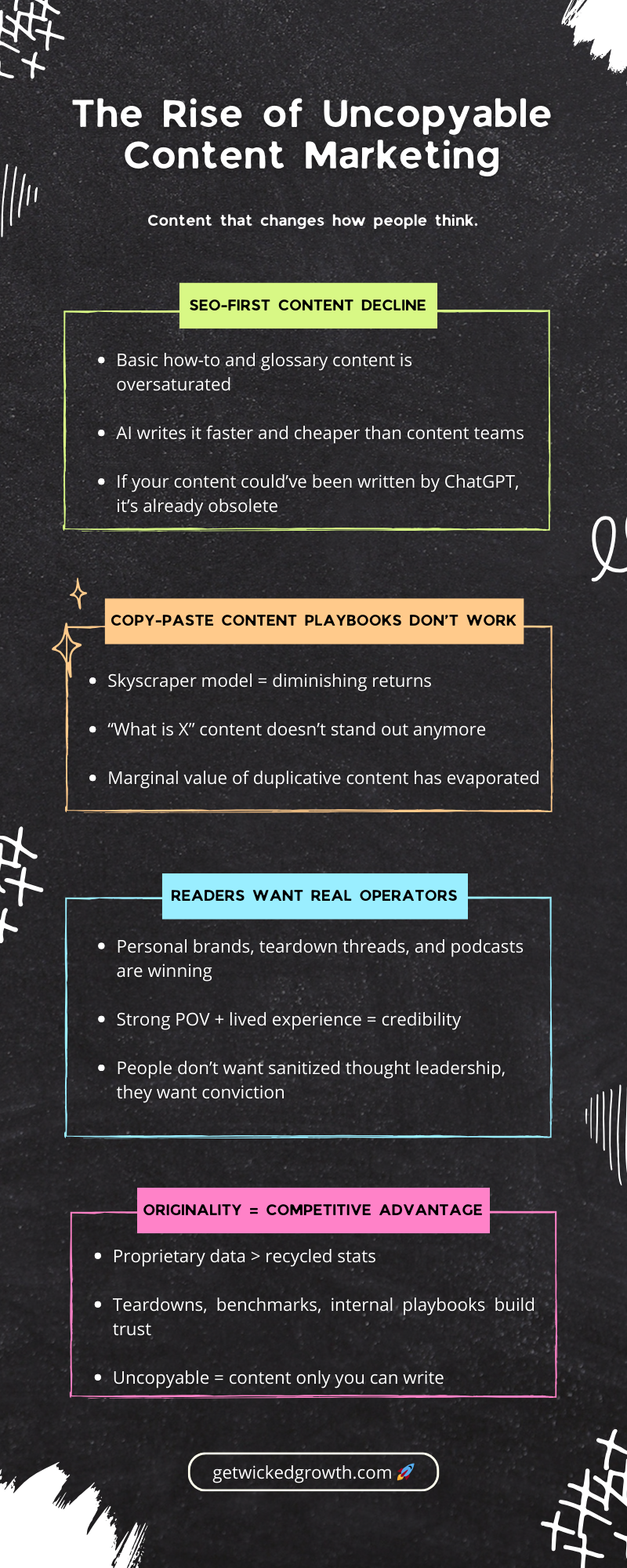
I’ve run those plays. I’ve seen the graphs go up. But over time, the marginal return faded.
Why?
Because your article on “What is CRM?” looks exactly like the next 20. Nobody remembers the 18th identical answer to the same question.
Plus, if you're selling a CRM software, chances are you're likely selling to someone with budget and has been in the industry for a decade. There's a good chance they already know what a CRM is and have probably used them before. ¯\_(ツ)_/¯
Then AI came in and made things worse for anyone stuck in the middle.
AI killed the middle, not the best
In 2023, ChatGPT and its cousins started writing basic content faster, cheaper, and in many cases, better than content teams could.
But AI didn’t kill great content. It killed anything that was average. Anything that could be templated. Anything phoned in. It made the gap between “good enough” and actually good wider than ever before.
If you’re still churning out SEO-first, insight-lite, consensus-driven content, you’ve already been replaced.
Readers have changed too
I see it every day. Readers don’t want another safe article. They want:
- Someone who’s done the work.
- A strong point of view based on experience.
- A reason to believe.
People want to learn from peers and operators. But they do not want to read another sanitized thought leadership post.
So what should companies actually create?
I asked this question to my followers on LinkedIn and the thought process by Aditya Ramakrishnan made a ton of sense:
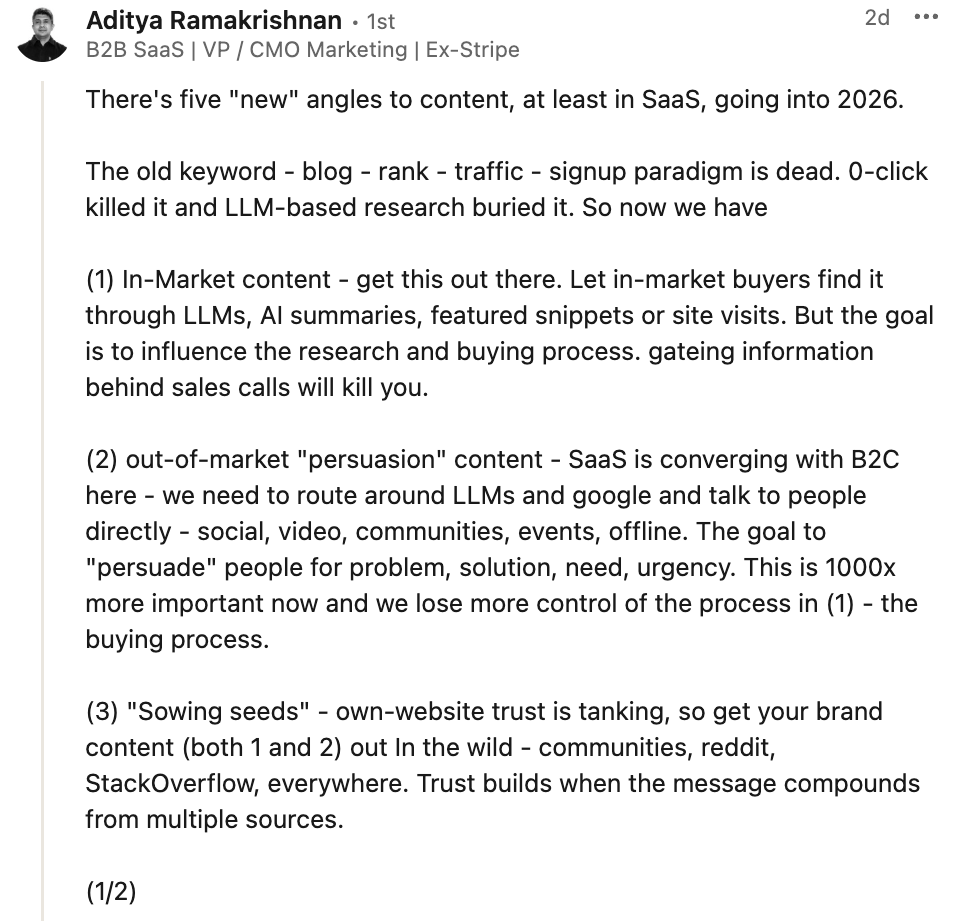
But...
If I had to take a 100-feet view at this problem, here’s what I’ve observed and learned.
If you want to stand out in 2025, your content needs to be un-copyable.
I believe content that looks smart but says nothing won’t survive. Only content that feels real, specific, and battle-tested will.
That means leaning into what only you can produce.

1. Proprietary insights
You’re sitting on data no one else has:
- Product usage patterns
- Sales cycle metrics
- Funnel benchmarks across your ICP
Don’t waste that. Turn it into:
- Market reports
- “We analyzed X accounts and found…” LinkedIn posts
- Patterns your customers are experiencing before they churn or convert
At RevenueHero, we did this with weekly benchmark reports. Not fluff. Actual usage data. Patterns no one else could publish.
And it made us look like the experts in their eyes.
Enjoying this content piece? I publish detailed breakdown like this. Want to receive them in your inbox? 😃
This approach also helped across the buying journey:
- Problem Unaware: It made prospects want to go check their own conversion numbers and made them realize problems they didn't even know existed by highlighting conversion numbers of other companies just like theirs.
- Problem Aware: It gave prospects a deeper understanding of their challenges with real data, allowing them to better articulate the pain points they needed to solve.
- Solution Aware: It positioned us as the authority. We gave away practical, validated frameworks and playbooks (more on this below), making our solution the natural next step instead of just "one of many" options.
If you have unique data points, you can also turn this into a programmatic SEO play like this.
Here's another great example: ChartMogul was able to pull data from 2500+ companies that showed when someone is likely to upgrade their account to an annual plan and turn it into a great marketing moment 👇
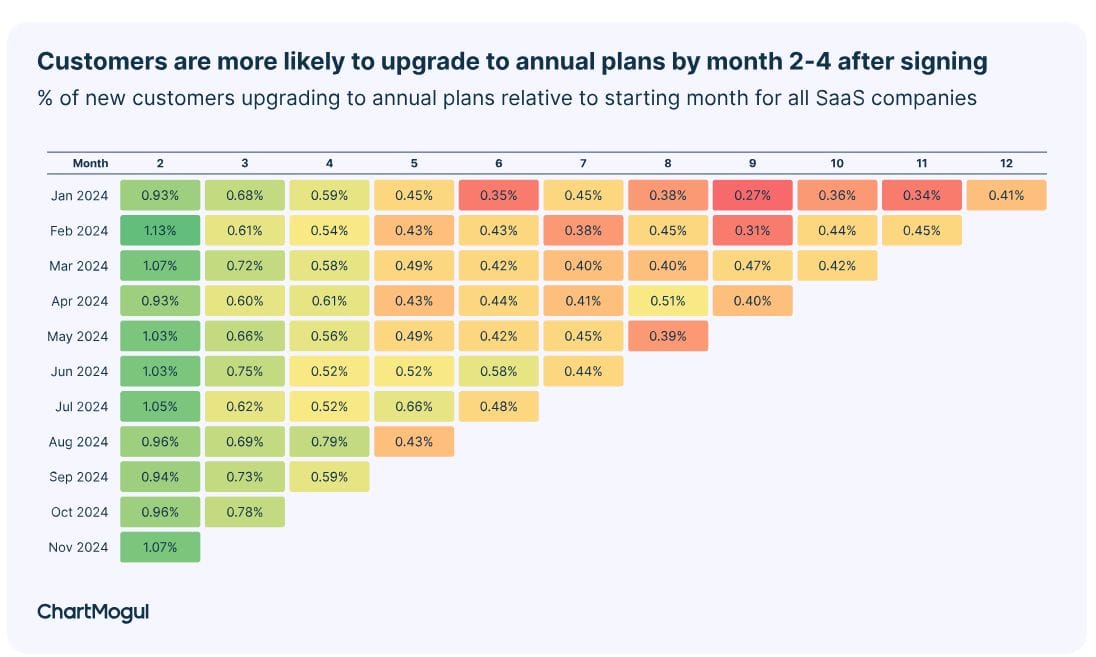
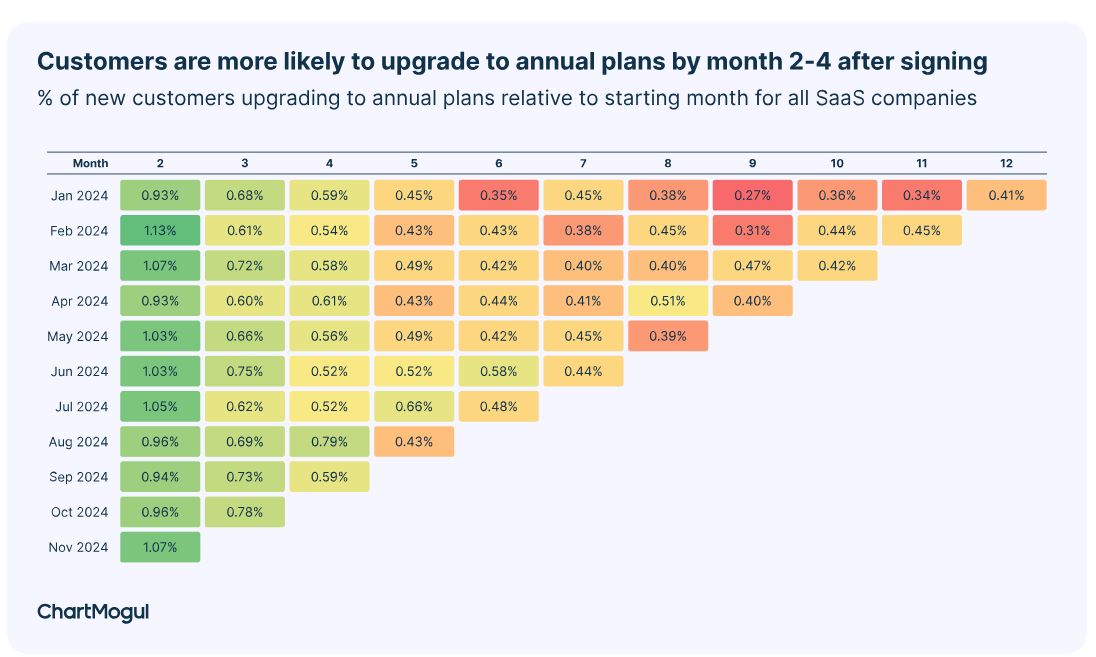
2. Playbooks, not brochures
Your content shouldn’t describe your product. It should show your thinking.
We did this at RevenueHero and called it as Playbooks. The goal was to create content to walk through the exact steps we took to solve the problems our market and ICP cared about.
- HubSpot Reports to measure SDR to AE outbound meeting handoffs
- How to use n-gram analysis to increase Google Ads conversions?
It really helped that the ICP we were going after were people who were a lot like me.
These content pieces we created weren’t case studies. We didn’t just say what worked. We also covered how you can replicate this success while talking about what didn’t work and why.
Today, people are craving more authentic experiences. They don’t just want another sanitized success story.
They want to know:
- What did THIS person do?
- How did THIS person solve that problem?
- What challenges did THIS person go through while trying to solve it?
- What were all the different things THIS person tried before figuring it out?
- And most importantly, what can I learn?
These are content pieces that are often written from the writer's perspective. It has a lot of "I" and personal experiences that shape the content. And it makes them more believable in the eyes of the reader.
This is why I believe companies that have founders or employees (who are also their core ICP) writing regularly and sharing what they're observing in the market are doing well. And if I'm being completely honest, influencer marketing done well is an extension of this.
Content that feels lived, not manufactured, is winning.
The best part?
When you create these kinds of content pieces, they're rooted in your core ICP's daily problems that can help you build your brand. And eventually connect it back to your product.
I don't think buyers are looking for another "ultimate guide". They’re looking for proof that you’ve walked the hard road they’re on.
Richard Makara and Niko, Co-Founders of reconfigured, are doing this really well👇

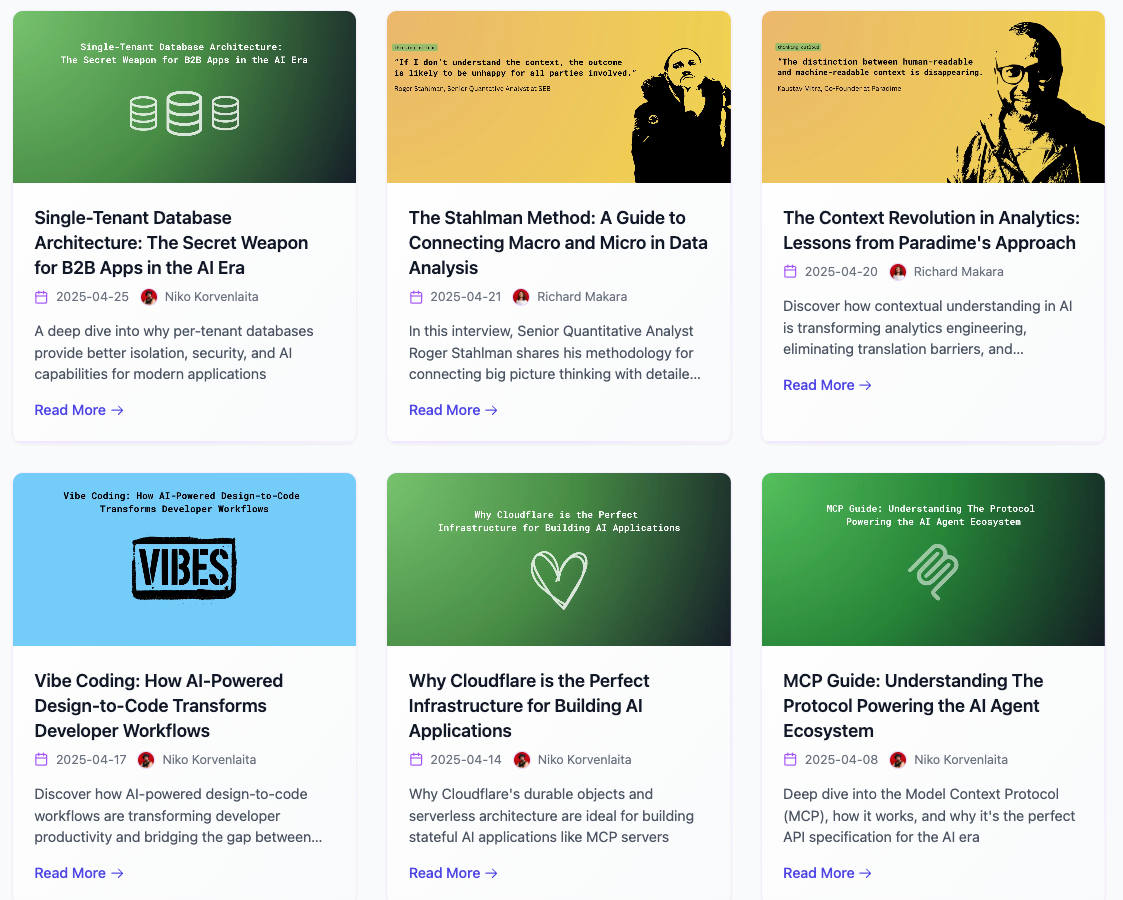
These content pieces aren’t just educational... They change how prospects see their problem, their priorities, and ultimately, their path forward (with your product).
Enjoying this content piece? I publish detailed breakdown like this. Want to receive them in your inbox? 😃
What to stop doing immediately
If you want to build a content engine that drives revenue and reputation, stop doing these four things:
- Writing articles because it’s Tuesday and there’s a publishing slot to fill.
- Letting keyword volume dictate your editorial calendar.
- Using content to introduce your product instead of solve a problem.
- Measuring success purely by traffic without context of influence or pipeline.
Redefining “Good Content”
Old definition: “It ranks.”
New definition: “It changes how people think.”
If your content doesn’t:
- Take a clear position
- Show what you would do in their shoes
- Back it up with data or lived experience
…it’s not moving the needle.
If it could’ve been written by your competitor, or worse, by GPT, you need to start over.
The path forward
Content marketing isn’t dead. But your old playbook probably is.
You don’t need to publish more. You need to say more of what only you can say.
So here’s my challenge:
Cut half your planned content. Replace it with:
- A teardown of a failed experiment.
- A benchmark no one else has.
- A playbook your ICP would gladly forward to their boss.
Because the top of the content game isn’t crowded. The middle is. And the only way out is up.
I’m betting on originality. On conviction. On content that couldn’t have been written by anyone else.
You should too.
Enjoyed this content piece? Show some love and help spread the word 😃


